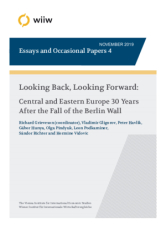Eastern Europe has come a long way in 30 years, but faces some serious challenges in a changing world
07 November 2019
To mark the 30th anniversary of the fall of the Berlin Wall, wiiw has produced a special report looking at the past, present and future of Central, East and Southeast Europe.
The report was presented at yesterday's panel discussion 'Looking back, looking forward: Central and Eastern Europe 30 years after the fall of the Berlin Wall' at wiiw.
The main conclusions are as follows:
- A large part of CESEE is significantly wealthier and healthier than it was in 1989. Every country except Ukraine has converged with Germany over the past 30 years.
- The fact that market capitalism and democracy have been established in so much of the region over the past three decades should not be underestimated. As our experts outline in the report, seen from the perspective of 1989 this was by no means a foregone conclusion.
- The EU Member States of the region have had a significant advantage over the rest of CESEE, including a much stronger reform anchor and large inflows of funds for public investment.
- A key driver of convergence for many CESEE countries has been integration with Germany and specialisation in the automotive sector. There is a risk, however, that they could become stuck in the production part of the value chain, and this could limit their prospects of catching up further.
- The independence and quality of institutions in much of CESEE has declined in the last decade. If this continues, it will present a problem for longer-term growth prospects.
- The future of CESEE is uncertain, especially considering the scale of population decline that the region is facing (and in many cases has already experienced), and the changing geopolitical and geo-economic backdrop.
- However, an active civil society in many countries, the new digital economy and the potential for automation in response to labour shortages all represent potential positives for the future.
The report is in three parts:
1. Statistical and descriptive overview of the past 30 years:
We assess transition and convergence quantitatively, from the following perspectives:
- GDP per capita
- Wages
- Life expectancy
- Demographic trends.
We find that, after a difficult start, most countries have become significantly wealthier and their populations have grown much healthier. This is particularly the case for EU-CEE countries, but also for parts of the Western Balkans. However, for others, the outcomes of the first 30 years are less positive. Ukraine in particular has had difficult three decades, and is poorer relative to Germany than it was in 1989. A large number of countries in CESEE have already experienced significant population decline, especially the Baltic states, parts of the Western Balkans, Ukraine, Romania and Bulgaria.
2. Essays by seven wiiw economists who lived through the transition, giving their perspectives on developments in the region over the past 30 years:
They assess CESEE as a whole, as well as the specific cases of Russia, Poland, Hungary, Romania, Ukraine, Yugoslavia and Czechoslovakia (and in case of the latter two also their successor states). Some believe that the ‘shock therapy’ of the early 1990s was necessary and – in the end – a success; others are more critical. Most express concern about current developments in the region.
3. A study summarising recent wiiw research on current challenges and the likely future of the region:
We find evidence of institutional regression, demographic challenges, and a changing geopolitical backdrop that will have important implications for much of CESEE. However, we also see reasons for optimism, including the opportunities provided by digitalisation and automation, and an active civil society that could in time force positive change.

